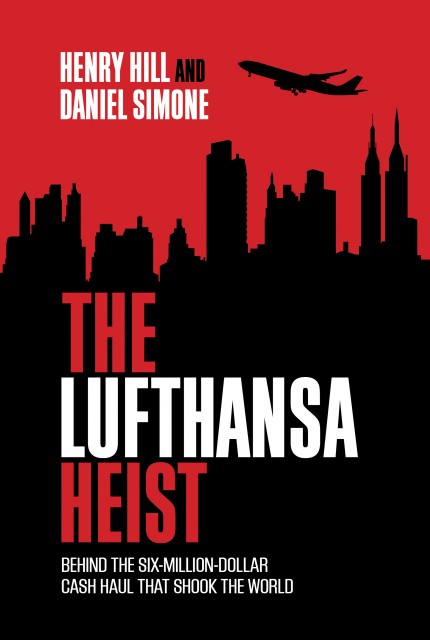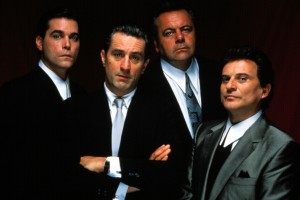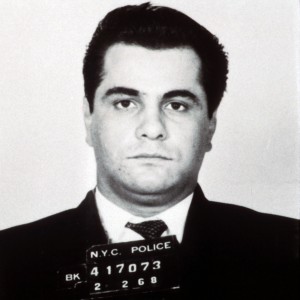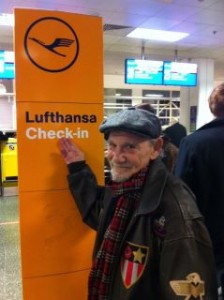Twenty five years ago, the Martin Scorcese film Goodfellas, was released to rave reviews and furious fanfare. With the wisecracking Joe Pesci as Tommy, the brilliant Robert De Nero as Jimmy the Gent Burke and Ray Liotta as the central character, Henry Hill, the movie chronicles a murderous tale of greed. The story, told from Henry Hill’s point of view after he turned federal informant, left out a few important details. It only hyper glosses over the actual Lufthansa Heist, and left out John Gotti’s role in the affair entirely.
But a new book that Henry Hill worked on shortly before his death in 2012, with author Daniel Simone, has been released to fill in all the missing details. Coinciding with the 25th Anniversary of Goodfellas, The Lufthansa Heist: Behind the Six-Million Dollar Cash Haul That Shook the World is available now and the book describes how a young John Gotti whacked the real life Joe Pesci character Tommy DeSimone.
The book also sheds light on a headline ripped straight out of todays news. Aging Mafioso Capo Vincent Asaro is about to go to trial for charges in connection with the Lufthansa Heist. He is actually the first person ever charged with the heist and the judge has ruled that no references can be made to the movie Goodfellas in the case.
The book actually casts doubts on federal prosecutors case against Asaro. The US Attorney’s office seems hell bent on convicting the Bonanno gangster and making him take the fall for the quarter century old crime, but Simone raises serious questions on whether he played a part in the robbery at all. And in classic Henry Hill form the book implicates everyone who was involved in the heist, detailing the part Mafia legend John Gotti played. Maybe Asaro should try to get the book entered into evidence. We sat down with Daniel Simone for a brief history lesson-
I met him by sheer coincidence at a fund raiser.
What interested you in writing the Lufthansa Heist?
When the robbery took place in 1978, I lived in the vicinities of Kennedy Airport. This brazen felony made blazoning headlines, and it entranced the public. Initially, Lufthansa disclosed that the amount of the theft was $2,000,000, then $3,000,000, and every week the total rose and rose. It was fascinating because the NYPD and the Port Authority suspected with reasonable certainty who had done it, but couldn’t muster sufficient evidence for a probable cause to arrest anyone. I also had another motivation inspiring me to write about this ballsy affront on Lufthansa, a remarkable coincidence. At that time, I was into a relationship with a young lady who was a Lufthansa stewardess, and for that reason I felt an intangible attachment to the event. And the media sensationalized it as if it were scripted in Hollywood, which glamorized what would have been just another burglary.
What was it like working on the book with Henry Hill?
It was tough. Henry often strayed from the subject, and wandered from one irrelevant topic to another. He seemed to find more pleasure in sharing his cooking recipes with me. (I, too, try my hand at cooking). Then on many days, Henry’s memory was hazy, and quite frequently he simply didn’t feel like discussing Lufthansa. He’d be anxious to move on with the morning and dive into unrelated activities, painting, signing promotional merchandise–and drinking.
Talk about the upcoming case and what it means?
I’m assuming you’re referring to the Vincent Asaro case. I spent almost two years interviewing Henry–and some of those sessions were videotaped. I had the collaboration of the two FBI agents who spearheaded the investigation (they wrote the forward and the afterward in my book). I also had the invaluable cooperation of Ed McDonald, the former US Attorney who was in charge of the case. (Incidentally, he played himself in Goodfellas). In my Notes and Sources page of the book, I name numerous individuals who were peripherally involved in the robbery; some on the sides of the authorities, and several down in the bowels of the underworld. Additionally, I managed to review a series of FBI inter-office memorandums circulated by those agents who were assisting the lead investigators identifying prospective suspects. And in the end of this exhausting mission, Vincent Asaro’s name never came up.
In fact, in January of 2014 the blasting news about Asaro’s arrest shocked not only me but the FBI agents, the former US Attorney, and everyone else who had been attached to the investigation. My conclusion, and that of the aforementioned parties, is that Asaro had nothing to do with Lufthansa. Perhaps, he might’ve pestered Jimmy Burke for a percentage of the loot, and maybe to appease him Burke tossed him a bone. But I can’t envision Asaro having partaken in the heist, and yet remain totally obscure. Moreover, he didn’t surface throughout my research and interviews with over a hundred people who had a direct and indirect participation in this crime of epic proportion.
So, you may ask, how could the current prosecutors obtain an indictment against Asaro for the Lufthansa charge? Simple. The indictment is based solely on the affidavits of two convicts, desperate felons in dire straits willing to fabricate lies that hey could offer to the prosecution in exchange for leniency. And the prosecutors, ambitious and blinded by the prospect of trying a case that will surely attract national attention, bought into those tales with hook, line, and sinker. The FBI also covertly recorded conversations wherein Asaro complains that “Burke never gave us what we were supposed to get from Lufthansa.” Such off-handed and fragmented statements, however, cannot be taken at face value and don’t necessarily mean what they imply. More realistically, it’s a commonality for the likes of Asaro to brag about crimes they did not commit.
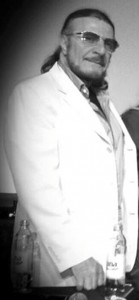 What did your research for the book involve?
What did your research for the book involve?
Well, it involved dealing with the unpredictable Henry Hill. Also, it was difficult locating and persuading people who were willing to freely discuss what they recalled about the robbery and its resulting murders, thirteen in all, which remain unsolved. And although those whom I spoke with had nothing whatsoever to do with Jimmy Burke’s slaughtering, and anyone who might’ve actually partaken in it is long dead, nonetheless, my sources were paranoid to utter a word about the killings. Mind you, statutes of limitations don’t apply to homicides. At first, even the FBI agents were reluctant to speak with me. As it eventually turned out, they became thrilled and willing to be affiliated with this book, which they fully endorsed. The third challenge was to round up the persons who consented to cooperate and arrange to videotape their debriefings. They’re now scattered all over the country, and that posed a scheduling nightmare. Obtaining public records was a hell of a struggle, too, and expensive, as were the transcripts from the trials.
Why do you think this crime and story still resonates today?
The Lufthansa Heist stands as the largest unrecovered cash haul in history, and unusually, none of the culprits were arrested and convicted. More captivating, the way the robbery unfolded gave the public reason to sympathize with the perpetrators. The bandits did not hurt the Lufthansa employees, whom they held captive for 55 minutes; nobody was hurt; the gunmen got away; the loot wasn’t recovered, and all this spins into a fascinating adventure that, in my opinion, the average citizen subliminally wishes for such an opportunity. Also, for the average John Smith eluding the authorities, as Jimmy Burke and his gang did, is a titillating notion. And 37 years later, it’s still a prosecutor’s dream to collar anyone who may have been remotely connected to Lufthansa. It just seems that when you speak of Lufthansa, it instantly seizes the media’s attention.
Besides Henry Hill, who were the main perpetrators of the crime and where are they today?
It all began with a Lufthansa shipping clerk, Louis Werner, a degenerate gambler who owed $20,000 to a bookmaker, Marty Krugman. Werner couldn’t repay the bookie, so he proposed a barter to him: information and details of how to steal millions of dollars from the Lufthansa Cargo Building in exchange for forgiveness of the $20,000 gambling debt. Krugman accepted and passed on the idea to Henry Hill, who in turn placed it in the hands of Jimmy ‘the Gent’ Burke. After persuading Lucchese Capo Regime Paul Vario to advance the seed money to organize the robbery, Burke assembled his squad of bandits. He chose his son Frankie, then Joe Manri, Robert ‘Frenchy’ McMahon, Angelo Sepe, Paolo Licastri,Tommy DeSimone, and Louis ‘Roastbeef’ Cafora. John Gotti supplied the warehouse in Maspeth, Queens, where the getaway van was unloaded and the packets of cash transferred to a switch car. Gotti also arranged for an auto wrecking yard in the Flatlands section of Brooklyn to crush and bail the getaway vehicle. Immediately after unloading the van, Burke instructed Stacks Edwards to drive it to the auto wrecking yard, but Stacks never got there. He derailed to his girlfriend’s apartment, leaped into the sack with her, snorted cocaine, and both fell asleep. The next morning, a police officer spotted the van parked too close to a fire hydrant, and that was the beginning of the end.
What was the significance of the heist when it took place?
On the morning of the heist, it was the main topic of every news station and newspaper headlines across the nation. The Lufthansa management wasn’t sure how much had been stolen. At first, they announced it might’ve been $2,000,000, which even so at present value equates to about $15,000,000. It was a stunning sum of cash! Then the FBI plowing in with forceful pursuit to take over the case re-ignited the media. A month passed, and amidst the cat fighting between the FBI, the NYPD, and the Port Authority jousting for the center stage of the investigation, no one had yet been arrested. Jimmy Burke and Henry Hill were prime suspects, but the authorities had no proof with which to charge them. Lufthansa finally admitted the amount missing was more like $6,000,000, and that was when Burke began the elimination of anybody who could’ve testified against him. More of immediate concern, he didn’t want to share the $6,000,000 with his bandoleros–it was cheaper to kill them, a sound business decision. Nothing personal. And bodies were turning up every week until the count reached thirteen.
A few months later, again Lufthansa flared up in the news when Hill was indicted for narcotics distribution. This is where matters got bizarre. Through a misinterpretation during the wiretaps of Henry Hill’s phones, the detectives became convinced that NYS Governor Hugh Carey was the kingpin of Hill’s drug ring. And the news flashes were endless.
Who spent all the money?
Jimmy Burke gave each of the six gunmen an average of $35,000. He gave his son, Frank, $1,500, and shared $200,000 with John Gotti, who quickly lost it at the local racetracks. Burke squandered about $800,000 on bad drug deals and general follies, and lost most of the fenced jewelry from the heist. He gave $1,000,000 to Lucchese Capo Paul Vario, and the rest of the booty he buried somewhere.
Goodfellas was the movie, is your book now the definitive story?
Goodfellas is a brilliantly crafted film. It’s fast-paced, and every minute of it is delightfully entertaining. But it wasn’t intended to delve at length into any one particular act; rather, it’s a string of synopses that hop seamlessly from one segment to the next. And of course, the Lufthansa caper is incidental and not central to the theme of the movie. Instead, my book focuses on the robbery with vignettes never before publicized. In it, Henry Hill and I set forth the events leading to the attack on the German airline cargo terminal, the 55 minutes armed robbery, and the carnage of the aftermath.
The infamous Boston College basketball point shaving scandal engineered by Henry Hill is one of the subplots of the story, a spectacular conspiracy that in itself could be a book. Last but not least, Henry and I, with the collaboration of FBI Agents Steve Carbone and Ed Guevara,US Attorney Ed McDonald, and Port Authority Police Chief Henry DeGeneste recreated the dramatic courtroom proceedings, and the aggressive rivalry between the FBI and the local police–a cat and mouse game that would’ve made an all time circus act. The book covers numerous incidents and developments omitted in Goodfellas, as well as page after page of hilarious revelations.
If you like this Check out Mafia Guys on Gorilla Convict.



